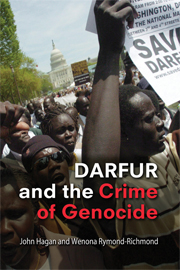Book contents
- Frontmatter
- Contents
- Glossary
- List of Characters
- Prologue: On Our Watch
- Darfur and the Crime of Genocide
- Settlement Cluster Map of Darfur, Sudan
- 1 Darfur Crime Scenes
- 2 The Crime of Crimes
- 3 While Criminology Slept with Heather Schoenfeld
- 4 Flip-Flopping on Darfur with Alberto Palloni and Patricia Parker
- 5 Eyewitnessing Genocide
- 6 The Rolling Genocide
- 7 The Racial Spark
- 8 Global Shadows
- Epilogue: Collective R2P
- Appendix: Genocidal Statistics
- Notes
- Index
- Titles in the series
- References
Notes
Published online by Cambridge University Press: 05 June 2012
- Frontmatter
- Contents
- Glossary
- List of Characters
- Prologue: On Our Watch
- Darfur and the Crime of Genocide
- Settlement Cluster Map of Darfur, Sudan
- 1 Darfur Crime Scenes
- 2 The Crime of Crimes
- 3 While Criminology Slept with Heather Schoenfeld
- 4 Flip-Flopping on Darfur with Alberto Palloni and Patricia Parker
- 5 Eyewitnessing Genocide
- 6 The Rolling Genocide
- 7 The Racial Spark
- 8 Global Shadows
- Epilogue: Collective R2P
- Appendix: Genocidal Statistics
- Notes
- Index
- Titles in the series
- References
- Type
- Chapter
- Information
- Darfur and the Crime of Genocide , pp. 237 - 262Publisher: Cambridge University PressPrint publication year: 2008

